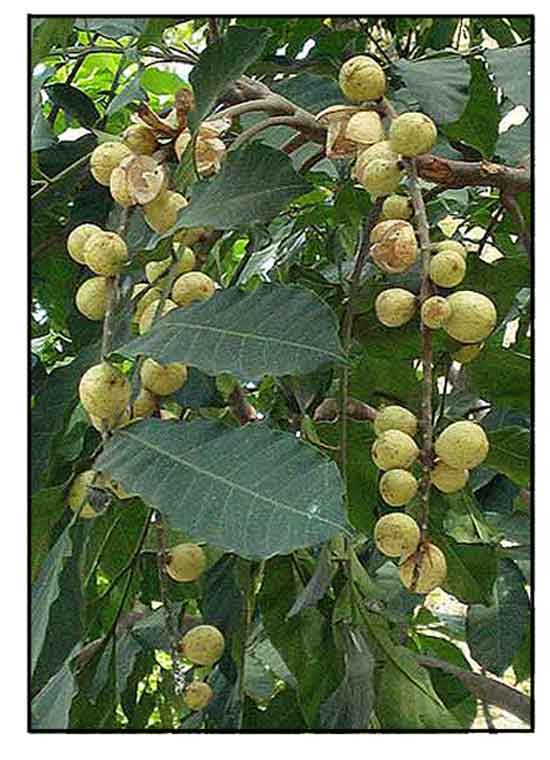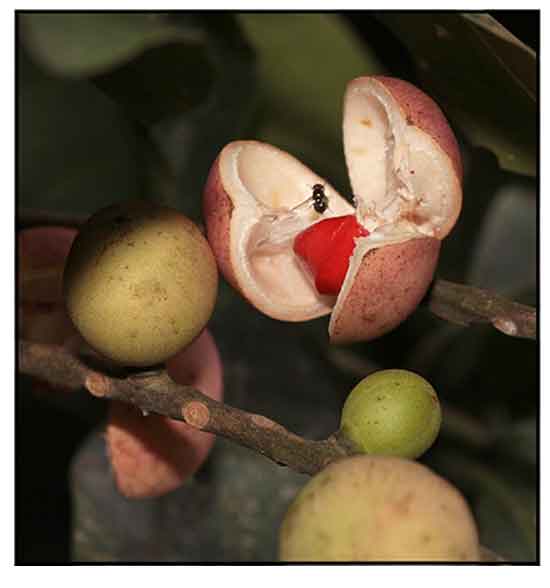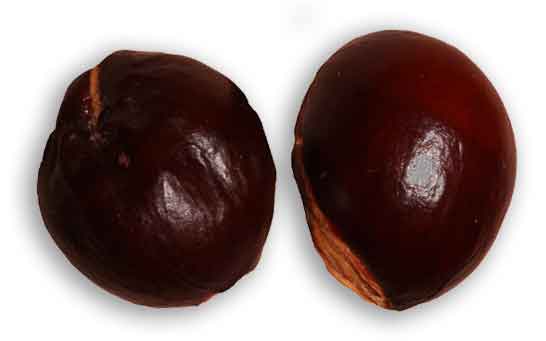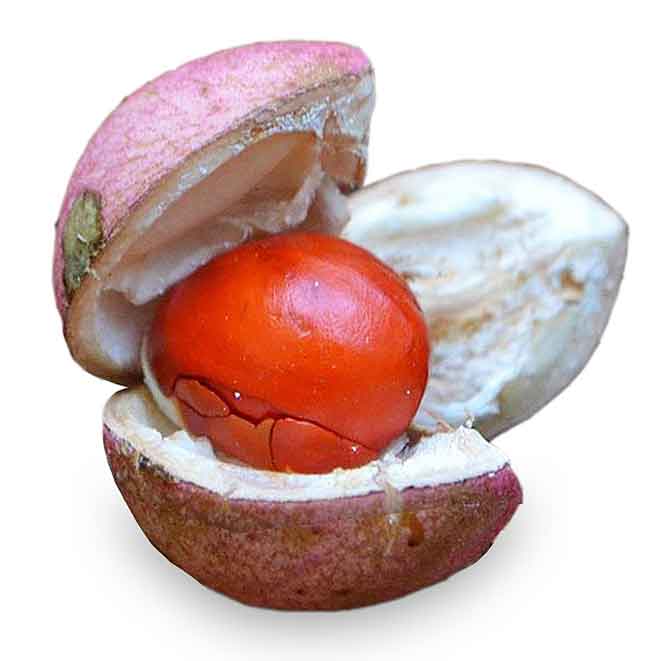 Gen info Gen info
- Etymology: The genus name Aphanamixis derives from Greek words aphanos meaning "invisible", mixis meaning "mating"; and the specific epithet polystachya from poly meaning "many" and stachys meaning "branch", referring to the much-branched male flowering shoot.
Botany
• Aphanamixis polystachya is a tree up to 20 m tall. Foliage: Alternate, stalked pinnate leaves are 45 x 125 cm long, with 6 x 10 pairs of leaflets. Its leaflets have slightly leathery blades that are oblong to elliptic-oblong, red when young, and 7.5 x 25 by 4 x 9 cm. The midrib is prominent on both surfaces. Flowers: Female flowering shoots are up to 110 cm long, while male and bisexual flowering shoots are up to 50 cm long. Its sweetly scented flowers are 4 x 9 mm across, and cream to yellow or bronze. Fruits: Pink-red-purplish fruits grow in clusters, are round to pear-shaped, and 2 x 4 cm across. Each fruit bears 1 - 3 seeds that are 17 x 22 mm long, covered with brownish-red or orange oily pulp, and have a dark brown or black seed coat. (2)
• Trees or shrubs, (2-)20-30 m tall. Leaves odd- or even- pinnate, 30-60(-90) cm; leaflets (5-)9-21, opposite; petiolules (2-)6-12 mm; leaflet blades oblong-elliptic, elliptic, or ovate, (7-)17-26 × 4-10 cm with basal pair smallest, membranous when young, subleathery to leathery when mature, with visible transparent tiny spots under sunlight, both surfaces glabrous, secondary veins (8-)11-20 on each side of midvein and slender, base oblique and cuneate to broadly cuneate or sometimes one side rounded, margin entire, apex caudate-acuminate to obtuse. Inflorescences axillary, less than 30 cm. Flowers 6-7 mm in diam., with 3 bracteoles. Sepals 5, suborbicular, 1-1.5 mm in diam., margin sometimes ciliate. Petals 3-7 mm in diam., concave. Staminal tube globose, glabrous; anthers 5 or 6, oblong. Ovary 3-locular, with thick trichomes. Capsule spherical-pyriform to nearly ovoid, 2-2.5 × 2.5-3 cm, orangish when mature. Seeds grayish brown, oblate, 1.3-1.5 × 1-1.2 cm. (Flora of China)
Distribution
- Native to the Philippines.
- Also native to Andaman Is., Assam, Bangladesh, Bismarck Archipelago, Borneo, Cambodia, China, East Himalaya, Hainan, India, Jawa, Laos, Lesser Sunda Is., Malaya, Maluku, Myanmar, New Guinea, Nicobar Is., Solomon Is., Sri Lanka, Sulawesi, Sumatera, Taiwan, Thailand, Vietnam
. (1)
 Constituents Constituents
- The n-hexane and methanol extract of seeds showed significant phenolic content of 12.0 and 11.7 mg GAE/g, respectively. (see study below) (10)
- Preliminary phytochemical screening of bark revealed presence of carbohydrates and saponins. (see study below) (11)
- Major compounds detected in essential oil of leaves included beta-elemene (16.04%), beta-eudesmol (12.78%), beta-caryophyllene (19.37%), beta-selinene (11.32%), elemol (5.76%), and alpha-humulene (5.68%). (see study below) (12)
- Study of aerial parts isolated 19 compounds, nine reported for the first time and ten known compounds.
The nine compounds were piscidinol A (2), 24-Epipiscidinol A (3), Toonamicrocarpavarin (4), Kumuquassin E (5), Bourjotinolone A (6), Niloticin (7), Dihydromacaticadienonic acid (8), Hispidol A (9), and Bourjotinoline B (10). The known compounds were ß-sitosterol (1), stigmasterol (11), aphanamexone D (12), aphanamixin B (13), nemoralicin (14), aphananin (15), aphanamixin (16), polystanin A (17), polystanin C (18), daucosterol. (19) (see study below) (15)
 - Study of seeds isolated aphanamoxene A-D (1-4), three new acyclic diterpene derivatives and one new acyclic norsesquiterpene. (see study below) (18) - Study of seeds isolated aphanamoxene A-D (1-4), three new acyclic diterpene derivatives and one new acyclic norsesquiterpene. (see study below) (18)
- Study isolated two unprecedented nemoralisin diterpenoid skeletone compounds, Aphapolin A and B, and a new natural product. (19)
- Phytochemical screening of root bark methyl alcohol extract yielded alkaloids, flavonoids, carbohydrates, reducing sugar, phytosterol, protein, anthocyanin, glycoside, coumarin, cardiac glycoside and tannin. Water extract yielded alkaloids, flavonoids, reducing sugar, phytosterol, saponin, and diterpenes. (24)
- GC-MS analysis of leaf extract revealed major constituents of 2-pentanone, different acids (octadec-9-enoic acid, 5-hydroxypipeloic acid etc.), and beta-elemene etc. (see study below) (26)

Properties
- Studies suggested antioxidant, cytotoxic, thrombolytic, anthelmintic, antimicrobial, membrane stabilizing, CNS depressant, analgesic, anticancer, antidiabetic, radioprotective, repellent properties.
Parts used
Leaves, bark, seeds.
 Uses Uses
Edibility
- Caution: Small red fruits reportedly toxic to humans.
Folkloric
- In traditional medicine, used as anthelmintic, hepatoprotective, antimicrobial, antirheumatic.
-
In Ayurvedic medicine, used for jaundice, ulcer, intestinal worms.
- Used to pacifiy vitiated vata and pitta; for splenomegaly, liver disorders, tumor, ulcer, dyspepsia, intestinal worms, diabetes, eye diseases, jaundice, hemorrhoids, burning sensation, rheumatoid arthritis,and leucorrhea.
(24)
- Bark used for treatment of colds and rheumatic pains.
- Seed oil used as liniment for rheumatic complaints.
- In Bangladesh, seed oil used for dressing sores; also applied on body to protect from insect bites. Flowers and roots mixed with coriander juice as antiobesity supplement. Juice from mashed fruits used as laxative and constipation relief. Chakma and Marma tribes drink a mixture of dried seeds and sugar in milk or water for liver disease and blood purification. Bark preparations drunk for heart and liver problems. In the Tripura districts, leaf decoction drunk for stomach ailments. (8)
Others
- Wood: Used for construction, ship-making, and furniture making.
- Repellent / Antifeedant: In Bangladesh, farmers apply seed oil on exposed body parts as protection from insect bites. Storage grans are safeguarded from pests using ground leaves, bark and seeds. (8) Mashed leaves in water solution used as antifeedant to protect crops against insects and pests. Extracts from twigs, bark, fruit and seeds are also effective anti-feedants. (see study below: 28)
- Oil: Oil can be used as biodiesel and for lighting.
- Soap: In India, seed oil used for making soap.
Studies
• Anthelmintic / Cytotoxic / Leaves: Crude methanolic extract, petroleum ether, and chloroform extracts of A. polystachya leaves showed good cytotoxic activity by brine shrimp lethality bioassay with LC50s of 11, 10.36, and 16.45 µg/mL, respectively. Crude methanolic extract showed moderate anthelmintic activity against Pheretima posthuma with Anova testing P value<0.05. (5)
• Antioxidant / Bark: Study evaluated the antioxidant activity of crude bark extracts of A. polystachya using NBT, DPPH, ABTS, and FRAP assays. Methanol, aqueous methanol, and water extracts exhibited potent antioxidant activity compared to known antioxidants. In vivo studies on potent fraction AP-110/82C showed dose-dependent reduction in hepatic malondialdehyde and catalase levels. Results suggest for a potent natural preventive intervention for free-radical-mediated diseases. (6)
• Cytotoxic / Antimicrobial / Antioxidant / Thrombolytic / Fruit: Study evaluated crude n-hexane, ethyl acetate, and methanol extracts of A. polystachya fruit for antimicrobial activity using disc diffusion assay, cytotoxic activity using brine shrimp lethality bioassay, antioxidant activity using DPPH, NO assay and TPC, and thrombolytic activity using clot lysis testing with streptokinase as positive control. n-Hexane extract showed highest antimicrobial activity against Shigella dysenteriae (ZOI 9.7 mm) and Candida albicans (ZOI 9.7 mm), while a methanol extract at same concentration showed ZOI 10.1 mm against Staphylococcus aureus. In BSLA, n-hexane, EA and methanol extracts showed LC50s of 15.77, 17.51, and 141.37 µg/ml respectively. All extracts showed significant clot lysis activity (p<0.001). (7)
• Antidiabetic / Antioxidant / Antibacterial /
α-Glucosidase Inhibitory / Leaves: Study evaluated A. polystachya leaf extract for antioxidant activity using DPPH assay, antidiabetic activity by α-glucosidase inhibitory testing, and antibacterial activity using agar diffusion assay. Results showed the leaf extracts were highly potent as antioxidant and α-glucosidase enzyme inhibitor, but was not effective in inhibiting bacterial growth. (9)
• Antioxidant / Antibacterial /
Thrombolytic
/ Seeds: Study evaluated seed extracts for in-vitro biological activities. Methanol extract exhibited antioxidant activity with IC50- 22.34 µg/mL and the n-hexane extract showed IC50 of 63,95 µg/mL compared to BHT of 14.01 µg/mL. Both extracts showed moderate clot lysis of 18.84% and 23.49% compared to streptokinase at 65.16%. n-Hexane and ME showed 18.2% and 32.2% inhibition of hypotonic solution induced hemolysis respectively. nH and ME showed cytotoxicity activity with LC50 13.45 and 1.61 µg/mL, respectively, compared to vincristine LC50 of 0.45 µg/mL. The methanol extract showed strong antimicrobial activity with zone of inhibition of 25 mm against S. aureus and moderate inhibition of 10mm against Shigella boydii, while the n-hexane extract showed no antimicrobial activity. Both extracts exhibited zero hemolysis. (10)
• Antibacterial
/ Stem Bark: Study evaluated petroleum ether, chloroform, alcoholic, and hydromethanolic extracts of A. polystachya stem bark for invitro antimicrobial screening using different bacterial strains in nutrient agar media. Zone of inhibitions suggested significant antimicrobial activity as compared to standard kanamycin. (11)
• Antibacterial
/ Essential Oil / Leaves: Study evaluated the medicinally potent chemicals in an essential oil extract of A. polystachya. Antibacterial properties were evaluated using disc diffusion method and GC-MS analysis for active oil components. All extracts exhibited potential antibacterial activity. The petroleum ether extract exhibited highly sensitive activity against all tested bacteria with inhibition zones of 8.83 to 11.23 mm, with lowest MICs of 32 to 256 mu g/mL against E. coli, S. lutea, X. campestris, and B. subtilis. Activity was attributed to major compounds detected in the essential oil. (see constituents above) (12)
• Membrane Stabilizing Activity
/ Stem Bark: Study evaluated various stem bark extracts for free radical scavenging, membrane stabilizing, and cytotoxic activities, using DPPH, erythrocyte in hypotonic solution, and vincristine as standard cytotoxic agent, respectively. A petroleum ether soluble partitionate of methanol extract of stem bark exhibited strong membrane stabilizing activity and antioxidant potentials, while crude extract and chloroform soluble fraction showed moderate membrane stabilizing and significant antioxidant potentials. A positive correlation was seen between total phenolic content and free radical scavenging activity. (13)
• Antihyperglycemic / Leaves: Study evaluated the antidiabetic effect of methanol extract of A. polystachya leaves in streptozotocin (STZ)-induced diabetic Wistar rats. Results showed a dose-dependent antidiabetic effect evidenced by significant decrease in blood glucose, body weight, total cholesterol, triglycerides, and increase in HDL. The antidiabetic effect may be attributable to plant phenolic and flavonoid contents in the methanol extract of leaves. (14)
• Anticancer / Polystanin A and Aphanamixin) / Aerial Parts: Study evaluated the bioactivity of 19 compounds isolated from aerial parts of A. polystachya. All isolates were screened for potential against a panel of cancer cell lines. Compounds 16 (aphanamixin) and 17 (polystanin A) showed excellent cytotoxic activity against prostate cancer with IC50 of 7.44 and 6.70 µM, respectively. Further cell cycle analysis showed both compounds induced necrosis in DU145 cells by arresting the cell cycle at S phase. Results suggest the aerial parts are a potential source of anticancer drugs. (see constituents above) (15)
• Central Nervous System Depressant / Analgesic / Leaves: Study evaluated the possible CNS depressant and analgesic activity of methanol extract of A. polystachya leaves in mice. Extract decrease motor activity and exploratory behavior of mice in hole cross and open field test (p<0.001) and significantly maximized duration of sleeping time with thiopental sodium (p<0.001) At doses of 250 and 500 mg/kg the extract produced significant (p<0.05 and p<0.001) increase in pain threshold in both hot plate and tail immersion methods in a dose dependent manner. Results were comparable to standard Nalbuphine. In acetic acid induced writhing test, 500 mg/kg dose produced maximum inhibition of 75% (p<0.001) compared to diclofena-Na 10 mg/kg with 78.1%. Results suggest strong CNS depressant and analgesic activity in mice. (16)
• Acyclic Terpenoids / Anti-Inflammatory / Seeds: Study of seeds isolated aphanamoxene A-D (1-4), three new acyclic diterpene derivatives and one new acyclic norsesquiterpene. The acyclic terpenoids (1-4) showed nitric oxide production inhibitory activity on lipopolysaccharide-induced RAW264.7 macrophages with IC50s of 17.6, 9.8, 16.6, and 14.2 µM, respectively. (18)
• Antibacterial against Antibiotic-Resistant Bacteria / Bark: Study evaluated A. polystachya leaf and bark extracts for antibacterial activity against three antibiotic-resistant bacterial species and one fungus. Methanolic leaf extract showed only limited antibacterial activity. Both methanolic and aqueous bark extract showed high antimicrobial activity. In antioxidant testing, leaf and bark extracts exhibited 50% free radical scavenging at concentration of 107.14 µg/mL and 97.13 µg/mL, respectively, indicating bark extracts have more antioxidative activity than leaf extracts. Molecular modeling of compounds revealed inhibition may occur by binding to active sites of target proteins of tested bacterial strains. Results suggest the bark extract as a natural source of drugs to control antibiotic-resiistant bacteria. (19)
• Anticancer / Stem Bark: Study evaluated the anticancer activity of methanolic extract and n-hexane fraction of A. polystachya stem bark by SRB assay of HeLa and MCF7 cell lines. The methanol extract and n-hexane fraction of stem bark powder showed most promising anticancer activity on HeLa cell line but moderate activity on MCF7. (20)
• Anticancer / Ehrlich Ascites Tumor: Study evaluated the anticancer activity of various doses of alcoholic extract of rohituka (Aphanamixis polystachya) in mice transplanted with Ehrlich ascites carcinoma (EAC). The extract using doses of 0, 0.125, o.25, o.5, 0.75, 1, 1.25, or 1.5 g/kbw and administered once daily for 9 consecutive days resulted in dose dependent regression in tumor mass and increase in tumor-free survivors. Greatest activity was observed with 1 g/kg. Administration of split dose of 0.5 g/kg of extract twice daily for 9 days resulted in greater number of tumor-free survivors than positive control doxorubin at 1 mg/kg. Extract administration increased lipid peroxidation two-fold accompanied by a two-fold decline in glutatione contents, reduced activities of glutathione reductase, glutathione-S-transferase, SOD, and catalase. Results suggest extract treatment caused a dose-dependent retardation in tumor mass and regressed tumors even in the late stages of tumor development. The cytotoxic effect may be due to increased lipid peroxidation, depletion of GSH, GSHpx, SOD, CAT, and suppression in transactivation of NF-kB. (21)
• Antidiabetic / Polyphenol-Standardized Leaf Extract: Study evaluated the antidiabetic and organ-protective effects of standardized leaves extract administered for 28 days to streptozotocin induced diabetic rats. Results showed significant decrease in blood glucose (p<0.001) and HbA1c (p<0.05) levels using doses of 250 and 500 mg/kg. AP reduced oxidative stress markers and showed substantial increase in antioxidant enzymes in diabetic animals. The 500 mg,kg dose showed comparable results to antidiabetic drug glyburide. Histological exam showed attenuation of kidney tissue inflammation and damage. HPLC analysis yielded polyphenols with antioxidant, antidiabetic, and organ protective agents: gallic acid, rutin hydrate, and quercetin hydrate. Results suggest a potential source of antidiabetic agents. (22)
• Protective against Radiation-Induced Chromosome Damage / Stem Bark: Study evaluated the protective effect of ethyl acetate fraction of A. polystachya on radiation-induced chromosome damage in bone marrow cells of Swiss albino mice exposed to various doses of γ-radiation. Irradiation caused dose dependent elevation in aberrant cells and chromosome aberrations like chromatid breaks, chromosome breaks, dicentrics, acentric fragments and total aberrations at all post-irradiation times studied. Results showed the extract protects bone marrow cells and the reduction in radiation-induced chromosome damage may be due to free radical scavenging and reduction in lipid peroxidation. The radioprotection by the extract is comparable to protection demonstrated by grape fruit flavonone, naringin, in an earlier study in mouse bone marrow cells. (23)
• Protective against Liver Inflammation, Fibrinogensis in Ovariectomized Rats / Leaves: Study evaluated the mechanisms of protective effects of ethanol leaf extract of A. polystachya on chemical-intoxicated hepatic inflammation and fibrosis in Long-Evans female ovariectomized rats. Intoxication with CCl4 caused oxidative stress, fibrosis, and inflammation in liver of rats. Treatment with leaf extract prominently mitigated the oxidative stress (TBARS, NO, APOP) and inflammatory (MPO) markers and improved endogenous antioxidant enzymes (catalase and SOD) activities in CCl4- intoxicated rats. Inflammation and fibrosis in the liver were prevented by extract and silymarin treatment. The extract may protect liver in CCl4-intoxicated rats by mitigating oxidative stress, inflammation, and fibrosis, and by augmenting function of antioxidant enzymes. (25)
• Liposomal Drug Delivery / Neurobehavioral Effects / Leaves: Neurodegenerative diseases (Alzheimer's, Parkinson's, etc) cause brain cell damage leading to dementia. A major restriction to drug delivery to the central nervous system is the blood brain barrier (BBB). Study reports on the development of a liposomal drug delivery system of A. polystachya leaf extract for treatment of neurodegenerative diseases such as AD or PD. Liposomal batches of A. polystachya leaf extract were prepared using design of experiment (DoE). Stability study of blank and leaf extract loaded liposome were performed in gastric media. In-vivo neurobehavioral and anti-inflammatory studies were performed in mice and rat models respectively. In-vivo neurobehavioral study data indicated significant improvement in memory function, locomotor activity, and ambulatory performance of dementia induce mice was observed for liposomal batches compared to merely A. polystachya leaf extract. (26)
• Antineoplastic in HeLa Cells / Correlation with Clonogenicity and DNA Damage: The antineoplastic activity of chloroform stem bark extract of A. polystachya (APE) was evaluated in cultured HeLa cells by clonogenic and micronucleus assays. Treatment of HeLa cells with doses ranging from 0-100 µg/ml APE showed concentration dependent reduction in cell survival up to 6h post treatment (p<0.005). A 6h treatment time was considered optimum for APE exposure. Clonogenic assay confirmed exposure of HeLa cells to different concentrations of APE resulted in concentration dependent decline in cell viability and 100 µg/ml resulted in 72% cell death compared to non-drug treated group. APE treatment increased the frequency of HeLa cells bearing more than one micronucleus (MN) indicating a higher degree of DNA damage. Study demonstrated that the APE is able to kill HeLa cells effectively, which may be due to its ability to induce DNA damage. (27)
• Repellent Properties against Sitophilus oryzae / Seeds: Study evaluated crude seed extracts of pithraj (A. polystachya) for repellency, feeding deterrency, contact toxicity, and oviposition deterrency to rice weevils. Extract showed strong repelled and feeding deterrent effects. The ethanol extract exhibited most toxicity of four extracts tested and showed lowest LD50s and LT50s. Ground leaves, bark, and seeds at 2.5% ratio provided good protection for rice grains by reducing the F1 progeny emergence and grain infestation rates. (28)
• Neuropharmacological Activity / Fruits: Study evaluated the neuropharmacological activity extracts and fractions of A. polystachya fruits by Hole cross, Hole board, and Elevated plus-maze test at doses of 200 and 400 mg/kbw. Results showed n-hexane, ethyl acetate, and methanol fractions of fruits have significant CNS depressant and anxiolytic activities in invivo animal models. (29)
Availability
Wild-crafted.
|

![]()








